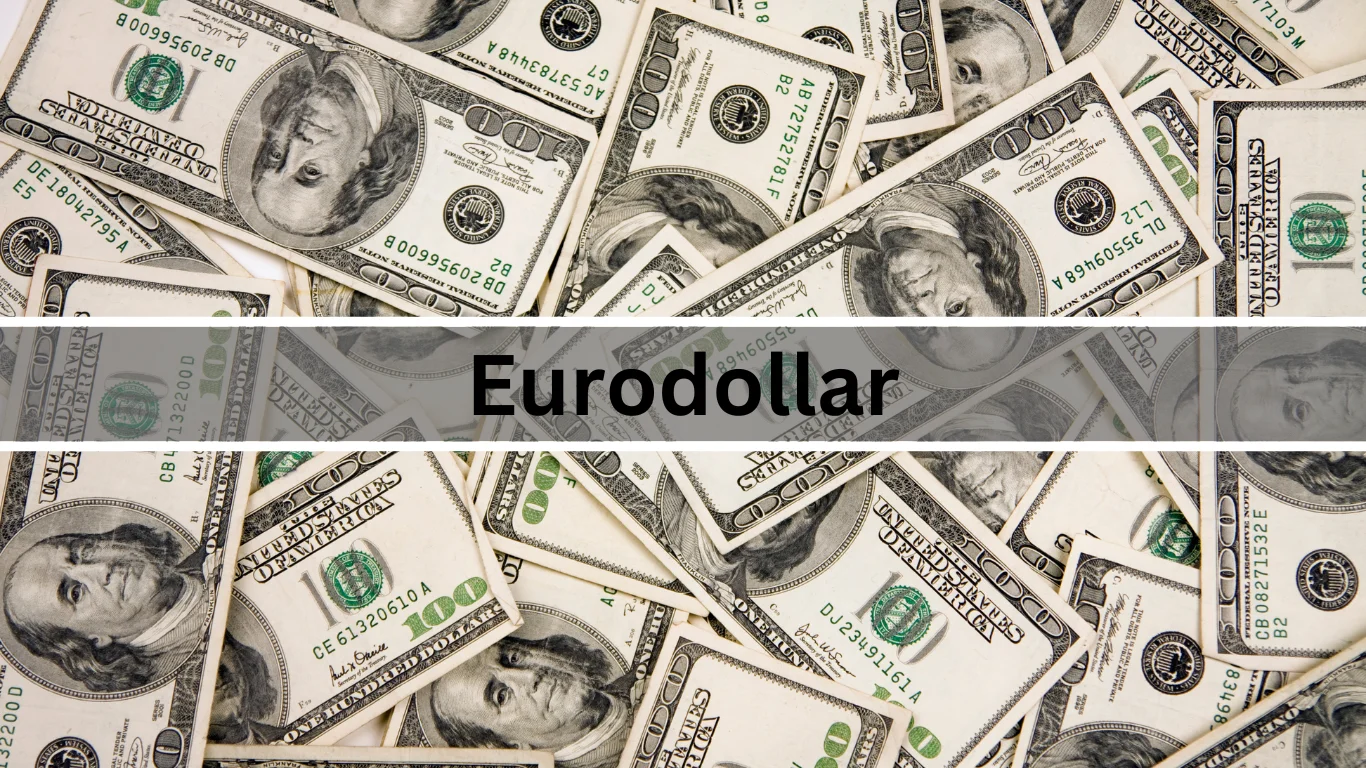Eurodollars, defined as U.S. dollar-denominated deposits located in banks outside the United States, play a pivotal role beyond the reach of Federal Reserve Board regulations. This absence of U.S. jurisdiction allows for nuanced interactions with inflation, interest rates, and broader economic factors, establishing Eurodollars as a crucial component of the global financial ecosystem.
Delving into the world of Eurodollars illuminates the mechanics of international banking and the influence of these deposits on global finance. This article will explore the origins, operation, and significance of Eurodollars, mainly focusing on how they relate to the United States, inflation, and interest rates, thereby offering a comprehensive guide to understanding this critical financial phenomenon.
History of the Eurodollar Market
The Eurodollar market’s origins trace back to the aftermath of World War II, catalyzed by the widespread distribution of U.S. dollars through the Marshall Plan. This period marked the beginning of U.S. dollar deposits in foreign banks, particularly in London, where the regulatory environment favoured international finance over domestic monetary constraints. The first significant growth spurt of the Eurodollar market occurred in the mid-1950s, driven by the Soviet Union’s quest for better interest rates on their dollar reserves, which were deposited in European banks to avoid potential U.S. sanctions.
Emergence and Expansion
- Initial Development: The market was initiated in London during the 1950s, influenced by a combination of high-interest rates and self-regulation by banks. London’s banks, leveraging the city’s flexible regulatory framework, began to attract large deposits of U.S. dollars.
- Innovation by Midland Bank: Recognizing an opportunity, Midland Bank 1955 spearheaded innovations that utilized high interest rates and changes in the forward exchange market, setting a precedent for other banks.
- Rapid Growth: By the late 1950s, the Eurodollar market saw exponential growth due to the U.K.’s exchange controls in 1957, which led banks to use dollar deposits as credit instruments for non-residents, effectively sidestepping restrictions on sterling credits.
The Eurodollar market not only provided a new source of international capital but also played a pivotal role in the Bretton Woods system. Its expansion was instrumental in the system’s eventual breakdown in the early 1970s, highlighting the market’s significant impact on global financial structures.
Mechanics of the Eurodollar System
Transactions and Participants
The Eurodollar system facilitates large-scale financial transactions, typically involving amounts of $1 million or more, with competitive interest rates. The market is characterized by its unofficial nature yet remains an indispensable component of the international monetary system. It operates with a high degree of flexibility and competitiveness, handling massive in-and-out movements of funds with minimal impact on interest rates. This market attracts investments due to its higher interest rates, varied maturity options, and broad spectrum of investment qualities compared to other short-term capital markets.
Flow of Funds and Market Operations
Funds flow into the Eurodollar market from approximately 40 to 50 countries across all continents, sourced from diverse entities such as official monetary institutions, government agencies, banks, business enterprises, and private individuals. These funds are then invested in numerous countries, including major economies like Japan and the United States. The market’s ability to operate under less regulation than domestic dollar markets presents both risks and benefits, enhancing liquidity and efficiency in the global financial system. Most transactions are conducted overnight, although maturities can extend beyond six months, typically structured as certificates of deposit (C.D.s).
Financial Instruments and Regulatory Environment
The Eurodollar market comprises sophisticated financial instruments such as fixed-rate time deposits, Eurodollar C.D.s, and floating-rate C.D.s and notes. These instruments are crucial for managing the liquidity and risks associated with international finance. Banks in the Eurodollar market can operate with narrower margins between borrowing and lending rates compared to their counterparts in the United States, primarily due to lesser regulatory constraints. This aspect allows them to offer more attractive rates and conditions, fostering a dynamic environment for international capital flow. Additionally, the market utilizes instruments like Eurodollar futures for hedging and speculating on future interest rate movements, further underscoring its complex and integral role in global finance.
The Role of Eurodollars in Global Finance
The Eurodollar market, encompassing a vast network of global finance, significantly influences international monetary policies and exchange rates. As a primary venue for lending and borrowing the world’s most important convertible currencies, the Eurodollar market facilitates substantial financial transactions that affect global interest rates and currency exchange rates. This market is not confined to any single geographic location and operates outside the regulatory frameworks typically associated with domestic banking systems, allowing for greater flexibility and responsiveness to global financial dynamics.
Transactions Impacting Global Interest Rates and Currency Exchange
- Arbitrage Opportunities: The Eurodollar market is intricately linked to a network of arbitrage transactions that stabilize short-term interest rates across different countries. By offering competitive interest rates for short-term funds, the market plays a crucial role in balancing the rates provided for present funds against future rates, which directly impacts global finance strategies.
- Influence on Exchange Rates: Through its extensive reach and the volume of transactions, the Eurodollar market also affects the exchange rates of major convertible currencies. This influence extends to the relationship between spot rates and future rates, providing critical data for forecasting and financial planning on an international scale.
The Eurodollar market’s ability to offer higher interest rates due to its offshore status and minimal regulatory oversight makes it an attractive option for a diverse range of participants, including commercial banks, private banks, and investment firms. These entities leverage the market’s flexibility to optimize their financial operations and enhance their liquidity management, contributing to the robustness of the global financial system. The market’s significant role in funding international trade further underscores its importance, as it provides essential capital for transactions that span multiple countries and currencies, thereby supporting global economic stability and growth.
Wrapping Up
Throughout this exploration of the Eurodollar market, we’ve delved into its historical roots, operational mechanics, and profound influence on global finance. From its inception in the mid-20th century to its development into a critical hub for international capital flow, the Eurodollar market has been shown to significantly impact global interest rates, exchange rates, and monetary policies. It serves as a testament to the innovation within the financial world, where demand and adaptability have birthed a system vital for global economic interactions, free from the constraints of traditional banking regulations.
As we reflect on the Eurodollar’s indispensable role in shaping the contours of international finance, we notice that it prompts a broader consideration of its future trajectory and the evolving challenges it might face in an increasingly interconnected world. The implications of this market extend far beyond its immediate participants, affecting global economic stability and growth. Thus, it invites further scrutiny and research into its mechanisms and potential influence on global financial trends, ensuring that stakeholders are well-equipped to navigate the complexities of the international financial landscape.
FAQs
Why is the Eurodollar considered important?
Eurodollars are highly valued due to their liquidity, making them an excellent source of international funding. Banks utilize these funds to offer loans in offshore markets or to manage risks in the eurocurrency futures market.
What does the term Eurodollar mean?
Eurodollars are U.S. dollar-denominated deposits held in foreign banks or the international branches of American banks. Since these are located outside of the U.S., they are not regulated by the Federal Reserve Board, which means they don’t have to adhere to reserve requirements.
What information can Eurodollar futures provide?
Eurodollar futures are a tool used by companies and banks to lock in an interest rate for future borrowing or lending. These futures are instrumental in hedging against potential changes in the yield curve over the coming years
How did the Eurodollar get its name?
The term “Eurodollar” originated in the early 1960s when Eastern European countries chose to deposit their U.S. dollar reserves in European banks to hold these funds outside the United States. Although it began in Europe, the term now broadly encompasses similar deposits held globally.




